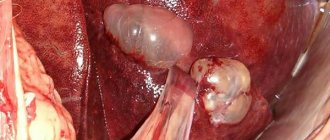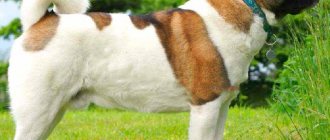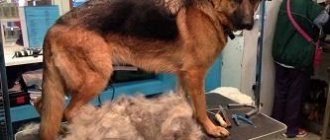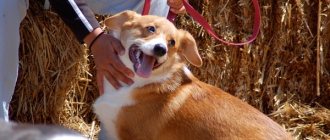Worms in dogs are a common problem and, unfortunately, no one is immune from it. The only salvation is timely prevention. The article contains basic information about helminthiasis in dogs: symptoms, treatment, preventive treatment regimen, review of popular drugs, prices.
Worm infestation in dogs can be asymptomatic for a very long time, so regular prevention is extremely important.
Internal parasites of dogs
Parasitism is a common form of existence of organisms, and helminths are perhaps the creatures most adapted to this. Their anatomy and physiology are aimed at the survival of not only one individual, but also the entire species.
Dog worms are internal parasites. They live in organs and tissues and cause helminthiasis. The development cycle of almost all of them is structured in such a way that the eggs leave the host’s body (usually with feces) and enter the environment, contaminating the soil, water, and plants. This way, they are more likely to end up in another organism, where they grow, multiply and again release their “offspring” outside to search for prey.
Some parasites develop with the help of an intermediary - an intermediate host, in whose body the egg turns into a larva, and only then infects the dog. They can be reptiles, birds, insects, rodents.
For example, the cucumber tapeworm, one of the most common helminths, settles in the small intestine of a dog and secretes oncospheres (capsules that contain up to 20 eggs). The “babies” of the worm come out with feces, where they are swallowed by the larvae of fleas and lice-eaters. In the body of insects they grow to “teenagers”, cystecircoids. When the blood-sucking parasite is eaten by the dog and enters the stomach, the cysticercoid will be released, attach itself to the wall of the small intestine and continue to grow, taking away nutrients from the host.
Causes and routes of infection
Veterinarians believe that the main causes of helminth infections are improper animal care. After all, before getting a pet, novice dog breeders do not delve into the rules of care and rarely adhere to the recommended diet. Some feed their animals what they eat themselves, while others let them go for long walks, leaving the animal without proper supervision. And at this time the dog can become infected with helminths, and then the larvae will get to the owner.
Read How to recognize allergies in a toy terrier: the best treatment methods
It is impossible to completely prevent a dog from becoming infected with helminths. However, it is still possible to reduce the risk. Helminths enter the animal’s body as follows:
- Through dirty water, contaminated food, from water bodies, from shoes and other items located on the street. It should be noted that helminth larvae can be almost anywhere, even on the grass.
- Fleas and mosquitoes serve as carriers; when they get on the animal’s fur, the dog begins to lick it and the larvae get inside and infection occurs.
- Helminths are transmitted to puppies from the mother during her pregnancy or during breastfeeding. Before mating adult dogs, it is also recommended to treat both dogs for worms to avoid infection.
Helminth eggs can be stored in the environment for a long time, so most often a dog becomes infected with worms by picking up food from the street or drinking water from a puddle.
The effect of worms on the body
Helminths poison the body with the products of their vital activity. They injure the tissues and organs in which they live, causing inflammatory processes. They worsen the course of concomitant diseases and negatively affect growth and development. Suppresses the immune and nervous systems. Reduce the effectiveness of vaccination. Some species promote the formation of tumors, including malignant ones.
In severe cases, helminth infections can be fatal.
Where can a dog get infected?
First in utero, then with milk or by swallowing helminth eggs that mom brought on her paws from a walk. And on the street, they wait for puppies at every turn, on sticks, in the grass, in puddles. Some species are carried by flies, mosquitoes, fleas and lice eaters. Hunting dogs often become infected during the season by eating raw meat of wild birds, animals, and fish. Contact with relatives or other animals can lead to helminthiases: rabbits, hedgehogs, frogs, rodents.
In addition, modern pets often travel with their owners and go to exotic countries, where they become infected with types of worms that are not found in their homeland.
Which dogs are at risk?
The risk of infection depends on the place of walking (how heavily it is infected with helminth eggs), and the state of the dog’s immune system. Pregnant and lactating women, the elderly, sick or weakened (with chronic pathologies, hypovitaminosis, including those in the recovery stage), and puppies under 12 months are more predisposed to developing the disease. and dogs exposed to heavy physical activity.
Some types of helminths can be transmitted from dog to person (toxocariasis, echinococcosis, unacinaria, pork tapeworm, diphyllobothrium)
Types of helminths in dogs, localization
There is an official scientific classification, according to which helminths are divided into three types:
Trematodes, or flukes
Parasitic flatworms with one or two suckers, hence the name. Mostly measured in millimeters, the largest species reach 2 cm.
- Alaria - dogs become infected with larvae when eating frogs, tadpoles, mollusks, mice, moles, ferrets, minks. Once in the digestive tract, the parasite gnaws through the passage and invades the lungs, where it matures to the sexually mature stage. Then it migrates into the oral cavity and again enters the intestines.
- Opisthorchia - in the mature stage they parasitize the liver, gall bladder, and pancreas. Infection occurs when eating freshwater shellfish or fish from the carp family that have been infected and have not undergone sufficient heat treatment.
- Paragonims are small pulmonary flukes that, in addition to the respiratory system, can settle in the brain. Dogs become infected by eating raw crabs and crayfish.
Nematodes, or roundworms
The most common type of helminths. Most are parasitic in the intestines.
- Hookworms are small worms up to 2 cm in length that settle in the small intestine and feed on blood.
- Dioctophyma - localization sites are: renal pelvis, abdominal cavity, ureters and bladder. You can become infected by eating earthworms. In addition, they can be intermediate hosts for capillaries (thread-like worms that parasitize the bladder).
- Toxocara causes one of the most dangerous diseases. Toxocara eggs are ingested with food, water, feces, or through contact with sick animals. Through the intestinal wall through the blood vessels, they migrate to organs and tissues, where they create a capsule around themselves and grow, causing various kinds of diseases.
- Trichocephalosis is caused by the whipworm, which affects the gastrointestinal tract. A widespread disease.
- Heartworm larvae are carried by mosquitoes. They enter the bloodstream and penetrate through the vessels into the lungs and heart, where they grow to the sexually mature stage.
- Thelyasia are parasites that live in the conjunctival sac. The carrier is the fruit fly.
Cestodes
They can be huge, up to 10 m in length, which is why they are often called ribbon ones.
- Dipilidia (cucumber tapeworm) - a dog becomes infected by eating blood-sucking insects. In the small intestine, the worm can reach 65 cm in length.
- Echinococcus and alveococcus - the first type is especially common in regions where sheep or pigs are raised. Alveococcosis most often affects hunting dogs working on wolves and foxes. A dog becomes infected with eggs when eating affected internal organs. In the small intestine, the parasites begin to grow, and then penetrate the blood vessels and are transported to the organs, where they turn into life-threatening echinococcal or alveococcal blisters. The liver, brain, lungs, kidneys, and muscles are most often affected.
Telasia in the eyes of an adult dog
Treatment of helminthic infestations in dogs
Before you start treating your dog, you should find out what parasite lives in its body. To do this, you need to contact a veterinarian and take a stool and blood test. Intestinal and liver helminths are detected in the feces, and heartworms in the blood.
Read Etiology of actinomycosis in dogs: signs, therapy and prevention
After the diagnosis, the doctor prescribes a deworming drug for dogs, which will help remove them from the body. Anthelmintics prevent parasites from feeding, and also cause paralysis in the worms.
Popular types of anthelmintics:
- Milbemax. Helps poison nematodes and cystodes.
- Drontal. Prescribed for worming adult worms living in the intestines.
- Vermox.
- Enwire. Allows treatment against any variety of roundworms.
- Azinox plus. The medicine is used against nematodes.
- Holiday plus.
- Dirofen. Prescribed to worm a puppy or unruly adults.
You can poison worms using drops that drip onto the dog’s fur.
These drops include:
- Inspector. Helps cure a dog of nematodes, fleas, ticks, and paralyzes intestinal parasites.
- Advocate.
- Leopard. The product is used to worm the animal to affect nematodes, ticks and fleas.
The drops are very convenient to use, the main thing is to choose places on the dog’s fur that are hard to reach so that it cannot lick off the medicine. To combat worming, the doctor prescribes syrups, suspensions and tablets; in more advanced cases, surgical intervention may be required.
Treatment with drugs breaks down worms, so they cannot be seen either in feces or in vomit. After administering the medicine, the pet must be closely monitored in order to be able to promptly provide assistance to it if it is necessary. Veterinarians advise giving your dog the medicine in the morning.
Adult dogs are given tablets wrapped in sausage or mixed into their food. For puppies, dissolve in water, pour into a syringe without a needle and pour into the oral cavity. If the dog becomes worse after taking the medicine, you need to give any absorbent agent and call a doctor at home. In this case, further treatment should be carried out under the supervision of a doctor.
How to determine if a dog has worms
Since the habitats of parasites are different, symptoms can vary greatly. Typical signs are:
Changes in appearance and behavior: lethargy, anemia, pale mucous membranes, dull and tousled hair, a tendency to dandruff and other skin diseases, signs of allergies. Developmental delay.
When the gastrointestinal tract is affected, indigestion, diarrhea or constipation, and bad breath are observed. The presence of blood, mucus, eggs or parts of parasites in the stool. Itching in the anal area. Bloating. Hiccups after eating, difficulty swallowing. With severe infestation, worms can cause intestinal blockage.
The presence of lungworms is accompanied by difficulty breathing, coughing, pneumonia and internal bleeding.
Heartworms, which include dirofilariasis, cause shortness of breath, wheezing and noise in the lungs, general exhaustion, disruption of the nervous system, fatigue and drowsiness.
Diagnosis and treatment
If you suspect or even believe that your dog has worms, you should not self-medicate. It is important to establish the type of parasite, and then make a prescription. To prevent the disease, the owner often chooses the drug on his own, taking into account the risks of infection, budget, age and breed.
In veterinary practice, a stool examination is prescribed to confirm the diagnosis. Along the way, the doctor may recommend a general and biochemical blood test, which will show the general condition of the body and the location of the problem. If there is a possibility of infection with worms that affect organs (heart, lungs, liver, bladder), you will need to do an ultrasound or x-ray.
Often, owners do not even realize that parasitic worms already live inside their pets.
Why are helminths dangerous for dogs?
How to understand that a dog is pregnant: signs in the early stages
Every dog owner should understand when a pet has worms. Infection with worms, regardless of which organ or system they are located in, can cause irreparable damage to the animal.
Worms gradually deplete and destroy the body from the inside. They take away nutrients that enter the dog's body along with food. Without receiving enough necessary substances, the dog begins to waste away, the functioning of internal organs is disrupted, which can lead to dire consequences.
The greatest danger is posed by worms that are found in the heart
Worms localized in the digestive tract disrupt intestinal motility and clog the intestines, causing obstruction. Treatment in this case consists of emergency surgery.
There is a high risk of severe intoxication of the body by by-products of the vital activity of worms. Against the background of poisoning, the functioning of the liver and kidneys is disrupted, which can lead to failure of these organs and result in the death of the pet. Worms can be localized in the heart and the blood vessels that feed it. Complication is the development of acute heart failure, followed by cardiac arrest.
It is necessary to find out that your pet has worms in a timely manner and immediately take measures to eliminate them, otherwise the animal may not have time to save.
Additional Information! For puppies, worms are a deadly phenomenon if they are not diagnosed and destroyed in time.
Considering the danger of a dog becoming infected with worms, every owner must take timely and regular preventive measures to prevent infection:
- The use of drugs to control worms - adult dogs need to be given them every six months, puppies - every 3 months.
- Regular wet cleaning of the house using disinfectants, special attention should be paid to the hallway and corridor, where people enter with shoes and can carry worm larvae from the street on the soles of their shoes and clothes.
- After each walk, you must thoroughly wash your pet's paws with water and detergents.
- The dog's bed, toys and other personal belongings should be regularly washed and washed with disinfectants.
- Natural food products should be thoroughly washed under running water. Fish and meat must be frozen or treated at high temperatures before being fed to an animal.
If the owner was able to recognize by the signs that the pet has worms, therapy should be carried out not only for the animal, but also for all family members.
Measures to prevent infection must be carried out systematically and regularly
Anti-worm medications: which one is better?
The modern market can offer many products for the treatment and prevention of parasitic infestations, but tablets remain the most popular. In each case, you must strictly follow the instructions and dosage. Prices are for reference and comparison purposes and may differ slightly from actual prices.
Drontal
The drug is from the famous company Bayer. Contains three active components and has a wide spectrum of action. Available in the form of chewable tablets, packed in a blister of 2 pcs.:
- For puppies, small breeds (1 tablet/10 kg) - 400 rub.
- For large breeds (1 tab./35 kg) - 600 rub.
Peculiarities:
- It works against tapeworms and roundworms, and also acts on protozoa (giardia).
- Not recommended for puppies less than 2 weeks old and weighing less than 2 kg.
- Not recommended in the first 40 days of pregnancy.
- Approved for use during lactation.
- Excellent palatability.
- Effective and versatile, but quite expensive.
- As a rule, there are no side effects or complications when used in accordance with the instructions.
- Belongs to low-hazard substances (class 4).
Previously, the Drontal Junior suspension was on sale, but it has been out of production for several years.
Helmimax
A drug produced by the company Apicenna (formerly Api-san). A two-component product with a fairly broad spectrum. The line includes several dosage options for tablets packed in blister packs of 2 pieces:
- Helmimax-4 (for puppies, small breed dogs) - 320 rub.
- Helmimax-10 (for puppies, medium breed dogs) - 420 rub.
- Helmimax-20 (for puppies, large breed dogs) - 450 rub.
Peculiarities:
- Acts against nematodes and cestodes.
- Prevention of dirofilariasis for up to 30 days.
- Allowed for puppies from 6 weeks weighing from 500 g.
- Baked chicken taste
- The small tablet is conveniently divided into 4 parts, which makes dosing and feeding easier.
- Lack of resistance in parasites.
- Not suitable for Collie, Sheltie, Bobtail dogs due to increased sensitivity to the components.
- Pregnant and lactating women are allowed under supervision no later than 3 weeks before birth and 2-3 weeks after birth.
- According to the degree of impact, it is classified as a moderately hazardous substance (class 3).
Gelmimax is recognized as the best choice of 2021 among similar drugs
Dirofen
Another popular antihelminthic drug from Apicena is the three-component Dirofen, available in the form of suspensions, pastes and tablets. All Dirofen drugs belong to hazard class 4. Convenient in dosage and well eaten by animals. Liquid forms also contain pumpkin oil, which stimulates the immune system and regeneration of the intestines damaged by worms.
Dirofen paste with milk mousse flavor is very well eaten by dogs
Prazicide (in the form of suspension and tablets)
The Apicenna company also offers dog owners a line of three-component drugs called Prazicide, which are available in the form of suspensions and tablets of 6 pieces. in a blister.
- Prazicide suspension for small breed puppies, 6 ml. (1 ml/1 kg) - 140 rub.
- Prazicide suspension for large breed puppies, 9 ml. (1 ml/2 kg) - 160 rub.
- Prazicide suspension for adult dogs, 10 ml (1 ml/3 kg) - 170 rub.
- Prazicide in tablets (1 tablet/10 kg) - 200 rub.
Peculiarities:
- Effective prevention and treatment of a wide range of nematodes and cestodes.
- Lack of habituation of parasites.
- The effect of the active ingredients is enhanced in combination.
- Convenient dosing of the drug according to the weight of the animal.
- Pleasant sweet taste
- Pregnant and lactating females are given under the supervision of a doctor 3 weeks before birth and 2-3 weeks after.
- It is excreted almost unchanged (93%) in feces.
- Contraindicated in sick and weakened animals, old animals, and puppies under 3 weeks of age.
- According to the degree of exposure, it is classified as low-hazard substances (class 4)
A line of three-component preparations Prazicide in the form of suspension and tablets
Melbemax
Two-component drug from Novartis, France. It is prescribed for prophylactic and therapeutic purposes against nematodes and cestodes, as well as the prevention of dirofilariasis. Considered one of the least toxic. Packaged in blisters of 2 tablets
- Furnituremax for puppies, small breed dogs (1 tablet/1-5 kg), 2 tablets - 447 rub.
- Furnituremax for large breed dogs (1 tablet/5-25 kg) only for dogs weighing over 5 kg - 670 rub.
Peculiarities:
- Works against tapeworms, roundworms, and heartworm larvae.
- Not recommended for puppies younger than 3 weeks.
- Not recommended in the first 40 days of pregnancy.
- Approved for use during lactation.
- Excellent palatability.
- Efficiency.
- As a rule, there are no side effects or complications when used in accordance with the instructions.
- Belongs to low-hazard substances (class 4).
One of the least toxic drugs against worms for dogs
Cestal plus
The drug is from the famous company Ceva. Recommended by breeders and veterinarians as an excellent three-component remedy with a wide spectrum against ascariasis, hookworm, cestodosis and trichuriasis.
One tablet per 5-10 kg. 2 tablets in a blister - 300 rubles.
Peculiarities:
- Not recommended for puppies under 3 weeks of age, or for pregnant women in the first 40 days.
- No other special precautions are required.
- Refers to drugs with low toxicity (class 4).
Chewable deworming tablets with liver flavor
Antihelminthics AVZ
Alben S
A low-cost domestic broad-spectrum product with two active ingredients is used against round and tape parasites. Acts on all stages of helminth development.
One tablet is designed for 5 kg, 6 tablets in a blister - 150 rubles.
Peculiarities:
- High efficiency.
- Wide spectrum of action against round and tapeworms.
- Ease of use.
- Contraindicated in puppies under 3 weeks of age.
- Not recommended for pregnant and lactating women.
Febtal
A single-component broad-spectrum anthelmintic against nematodes and cestodes, effective at all stages of development.
Febtal is available in 6 tablets. in a blister (adults 1tb/1.5kg, puppies 1tb/3kg) - 170 rubles.
Features:
- High efficiency.
- Maximum safety of use.
- Allowed for pregnant and lactating animals.
Dironet
A three-component drug with a wide spectrum of antimicrobial action against nematodes, cestodes and heartworm larvae.
- Dironet 200 for puppies, adult dogs of small breeds (10 tablets, 1 tab/4 kg) - 250 rub.
- Dironet 500 for medium breed dogs (6 tablets, 1 tab/10 kg) - 300 rub.
- Dironet 1000 for large breed dogs (6 tablets, 1 tab/30 kg) - 460 rub.
Peculiarities:
- Wide spectrum of action.
- Efficiency.
- Convenient dosage.
- Aromatic flavoring additive.
- Use collie, sheltie, bobtail and their mixed breeds with caution, after consulting a doctor.
- Do not use on puppies under 3 weeks of age.
The use of antiparasitic drugs in recommended doses is safe for the pet’s health
How to remove worms from a dog
If you suspect your dog is infected with worms, you should consult a specialist. Only a veterinarian can determine the type of parasite and prescribe effective treatment. Self-therapy is unacceptable and often leads to dire consequences for the health and life of the pet.
The most frequently prescribed and effective anthelmintic drugs are:
- Prazitel – affects all types of worms (flat, round, tape). Approved for the treatment of puppies.
- Milbemax – relieves the dog of tapeworms and roundworms.
- Drontal Plus is a powerful remedy against tapeworms, but has no effect on parasite larvae.
- Kanikvantel is a German broad-spectrum drug that is effective against worms. Cannot be used for allergy sufferers.
Before you start removing worms from a dog, you first need to rid the animal of fleas (drops, shampoos). An anthelmintic drug is given strictly according to the weight of the animal; an overdose can lead to severe intoxication.
Most modern parasite remedies do not require a prior fasting diet, so they can be given at any time of the day. The tablets should be thoroughly crushed and mixed with a small amount of food (minced meat, canned food).
After 10 days, the procedure is repeated again (this is necessary to destroy the worm larvae that hatched from the eggs during this period).
Every 3 months, dogs must be dewormed again; some experts allow the treatment of domestic (non-outdoor) animals to be repeated once every six months.
Procedure for using deworming products
Anthelmintic drugs are prescribed solely according to the instructions and strictly in accordance with the weight of the animal. For prevention, once, before morning feeding with a small amount of food or treat. If necessary, forcefully. A starvation diet and laxatives are not required before treatment.
- Puppies are first treated at the age of 3 weeks. If there is a high risk of infection within 14 days, but only with drugs that allow this according to the instructions.
- The repetition is carried out at 6 and 8 weeks. If there is a high risk of infection, an additional 10-12 weeks.
- Then every 2-3 months until reaching 1 year.
- Throughout life, preventive treatments are carried out once every 3-4 months. A repeat after 10-14 days may be required if helminths have been released or other symptoms of infection appear.
It is recommended to adjust the time of deworming so that it is carried out:
- 3-4 weeks before vaccination of adult dogs;
- 5-7 days after treatment for external parasites;
- 3 weeks before mating. After giving birth, it is recommended that the nursing mother be treated together with the puppies.
Therapeutic deworming is carried out at least 2 times with an interval of 10-14 days, which is due to the development cycles of parasites. For some helminthiasis, specific drugs can be prescribed by a doctor for 3 days in a row.
Additional preventive measures
- Wash food well and process (scald, freeze) fish and meat, offal;
- When walking, do not allow the animal to eat anything;
- Limit contact with stray dogs;
- Prevent the appearance of external parasites (fleas, ticks, lice eaters);
- Wash paws after a walk;
And most importantly, at the slightest sign of illness in your dog, always contact a specialist.
Worms in dogs are much easier to prevent than to treat.
Prevention of worms in dogs
It is impossible to completely protect your pet from parasites. But this does not mean that the risk of infection cannot be reduced.
Be sure to regularly carry out preventive deworming. Give your dog an anti-worm tablet every 3 months. And even if there are no symptoms, have your dog’s stool and blood tested at least once a year.
Do not feed your pet raw meat and fish. Boil them or scald them with boiling water. Of course, under no circumstances allow your dog to drink from puddles, rivers, lakes, or eat anything on the street.
Remove fleas and get rid of ticks in a timely manner, use special products and shampoos. Make sure your dog does not interact with stray animals.
If you follow simple prevention rules, you won't have to worry about your pet getting infected. And if this happens, immediately contact a specialist.
The article is for informational purposes only. Contact your veterinarian!










